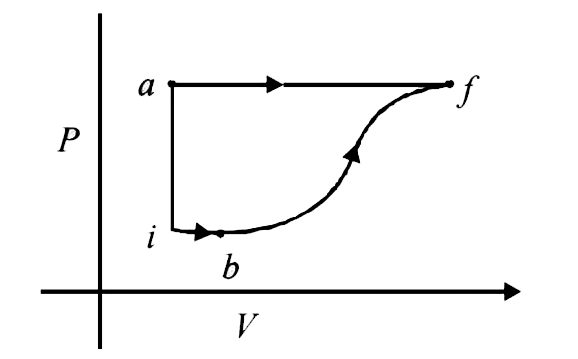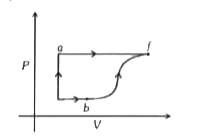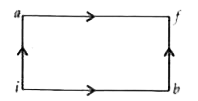A thermodynamic system is taken from an initial state I with internal energy Ui=−100J to the final state f along two different paths iaf and ibf, as schematically shown in the figure. The work done by the system along the pat af, ib and bf are Waf=200J,Wib=50JandWbf=100J respectively. The heat supplied to the system along the path iaf, ib and bf are Qiaf,Qib,Qbf respectively. If the internal energy of the system in the state b is Ub=200JandQiaf=500J, The ratio QbfQib is
 Solution in Gujrati
Solution in Gujrati
The correct Answer is:2
Qiaf=Wiaf+ΔUiaf
500=200+ΔUiaf
Uiaf=300
Uf=400
Qfb=Wfb+ΔUfb
=50+100
Qib=150
Qbf=Wbf+ΔUbf
=100+200
Qbf=300
QbfQfb=300150=2 ans
Topper's Solved these Questions
- GEOMETRICAL OPTICSBOOK - ALLEN CHAPTER - GEOMETRICAL OPTICSEXERCISE - EXERCISE - 05 (B) (MCQ)
9 Videos
- GEOMETRICAL OPTICSBOOK - ALLEN CHAPTER - GEOMETRICAL OPTICSEXERCISE - EXERCISE - 05 (B) (MATCH THE COLUMN)
3 Videos
- GEOMETRICAL OPTICSBOOK - ALLEN CHAPTER - GEOMETRICAL OPTICSEXERCISE - EXERCISE - 05 (A)
73 Videos
- CURRENT ELECTRICITYBOOK - ALLEN CHAPTER - CURRENT ELECTRICITYEXERCISE - EX.II
66 Videos
- GRAVITATIONBOOK - ALLEN CHAPTER - GRAVITATIONEXERCISE - EXERCISE 4
9 Videos
Similar Questions
Let ¯v,vrms and vp respectively denote the mean speed, the root-mean - square speed, and the most probable speed of the molecules in an ideal monoatomic gas at absolute temperature T. The mass of a molecule is m:-
View SolutionFor the given process :-
_E01_426_Q01.png)
Column-IColumn-II(A)Process J→K(P)W>0(B)Process K→L(q)W<0(C)Process L→M(r)Q>0(D)Process M→J(s)Q<0
View SolutionAn aluminium sphere of 20cm diameter is heated from 0∘C to 100∘C. Its volume changes by (given that the coefficient of linear expanison for aluminium (αAl=23×10−6/0C)
View SolutionIn the Bohr's model of hy drogen atom, the electron moves around the nucleus in a circular orbit of radius 5×10−11m. Its time period is 1.5×10−16s. The current associated with the electron motion is:-
View SolutionAssertion : The difference in the value of acceleration due to gravity at pole and equator is proportional to square of angular velocity of earth.
Reason : the value of acceleration due to gravity is minimum at the equator and maximum at the pole.
View SolutionA thermodynamic system is taken from an initial state I with internal energy U_i=-100J to the final state f along two different paths iaf and ibf, as schematically shown in the figure. The work done by the system along the pat af, ib and bf are W_(af)=200J, W_(ib)=50J and W_(bf)=100J respectively. The heat supplied to the system along the path iaf, ib and bf are Q_(iaf), Q_(ib),Q_(bf) respectively. If the internal energy of the system in the state b is U_b=200J and Q_(iaf)=500J , The ratio (Q_(bf))/(Q_(ib)) is
View SolutionWhen a system is taken from state i to state f along the path iaf, it is found that Q=50 cal and W=20 cal . Along the path ibf Q=36cal . W along the path ibf is
View SolutionWhen a thermodynamic system is taken from an initial state I to a final state F along the path IAF, as shown in Fig. the heat energy absorbed by the system is Q=55J and work done by the system is W=25J. If the same system is taken along the path IBF, the value of Q=35J.
(a) If W=−15J for the curved path FI, how much heat energy is lost by the system along this path ?
(b) If U1=10J, what is UF ?
(d) If UB=20J, what is Q for the process BF and IB ?
View SolutionWhen a system is taken from a state i to a state f in Figure, along the path iaf , we find DeltaQ=50cal and DeltaW=20cal while during the path ibf , DeltaQ=36cal . If U_i=10cal . (a) What is U? What is W along the path ibf ? (c ) If W=-13cal , along the curved path fi , what is DeltaQ for this path? (d) If U_b=22cal , what is DeltaQ for the process ib ? for bf ?
View SolutionA thermodynamic system is taken from an initial state I with internal energy U_(i)=100 J to the final state f along two different paths iaf and ibf, as schematicallly shown in the figure. The work donw by the system along the paths af, ib and bf are W_(af)=200 J,W_(ib)=50J and W_(bf)=100 J respectively.the heat supplied to the system along the path iaf, ib and bf are Q_(iaf)Q_((jb) and Q_(bf) repsectively.If the internal energy of the system in the state b is U_(b) =200 J and Q_(iaf) =500J, the ratio Q_(bf)//Q_(jb) is In the figure a container is shown to have a movable(without friction) piston on top. The container and the piston are all made of perfectly insualting material allowing no heat transfer between outside and inside the container The container is divided int to two compartments by a rigid partition made of a themally conducting material that allows slow tranfer of heat.The lower compartment of the container is filled with 2 moles of an ideal monatiomic gas at 700 K and the upper compartment is filled with 2 moles of an ideal diatomic gas at 400 K.The heat capacitites per mole of na ideal monatomic gas are C_(v)=(3)/(2)R,C_(p)=(5)/(2)r, and those for an ideal diatomic gas are C_(v)=(5)/(2)r,c_(p)=(7)/(2)R .
View SolutionA system is taken from state A to state B along two different paths 1 and 2 . The heat absorbed and work done by the system along these two paths are Q_(1) and W_(1) and W_(2) respectively.
View SolutionA thermodynamic system is taken an initial state i with internal energy Ui=100J to the final state f along two different paths iaf and ibf, as shown in figure. The work done by the system along the paths af, ib and bf are Waf=200J,Wib=50JandWbf=100J respectively. The heat supplied to the system along the path iaf,ibandbfandQiaf,QibandQbf respectively. If the internal energy of the energy of the system in the state b is Ub=200J and Qiaf=500J then find out the ratio of Qbf/Qib.
View Solutionएक ऊष्मागतिक तंत्र (thermodynamic system) अपनी प्रारम्भिक अवस्था । जिस पर उसकी आन्तरिक ऊर्जा U1=100J है, से अन्तिम अवस्था तक दो भिन्न पथों iaf तथा ibf के अनुदिश लाया जाता है, जैसा चित्र में दर्शाया गया है। पथ af, ib तथा bf के लिए किया गया कार्य क्रमशः Waf=200J,Wib=50J तथा Wbf=100J है। पथ iaf, ib तथा bf के अनुदिश तंत्र को दी गई ऊष्मा क्रमशः Qiaf,Qib तथा Qbf है। यदि अवस्था b पर तंत्र की आन्तरिक ऊर्जा Ub=200J तथा Qiaf=500J, है तब अनुपात Qbf/Qib होगा

View SolutionWhen a system is taken from state I to state f along the path iaf, it is found that Q = 50 cal and W = 20 cal. Along the path ibf, Q = 36 cal. W along the path ibf is

View SolutionA system is taken from state A to state N along two different paths 1 and 2. The heat absorbed and work done by system along these two paths are Q1 and Q2, and W1 and W2 respectively. Then
View SolutionA system is taken from state A to state B along two different paths 1 and 2. The heat absorbed and work done by the system along these two paths are Q1andQ2,andW1andW2 respectively.
View Solution
